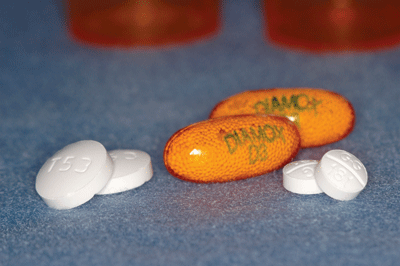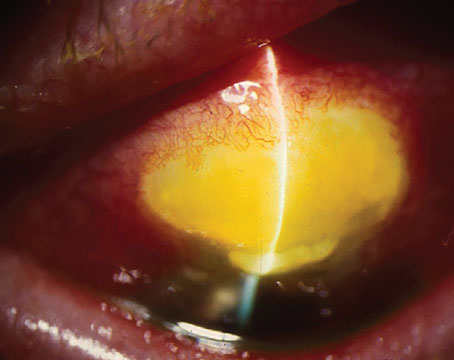In fact, it's become increasingly easy to overlook the oral CAIs when deciding how to treat a patient. Yet they can do a very effective job of lowering IOP and keeping it at a safe level. Here, I'd like to offer a reminder of some of the situations in which these drugs can be useful.
An Effective Option
The primary reason oral CAIs aren't prescribed as frequently as topical drops is the potential for systemic side effects, which are rare with eye drops. Diamox, especially at higher doses, causes many patients to experience tingling, gastrointestinal upset and increased urination, and other more severe problems are possible. Neptazane has fewer side effects than Diamox, but it's also a weaker drug. [For more on CAI side effects, see below.]
 |
| Methazolamide and acetazolamide effectively lower IOP, and can be used in ways that minimize or eliminate potential side effects. |
However, the fact remains that oral CAIs are effective. Diamox reduces aqueous flow 21 to 30 percent during the day and 24 percent at night (an advantage not shared by beta-blockers).1,2 And I've found oral CAIs to be significantly more effective than topical CAIs in many patients. I've had patients using dorzolamide referred to me with an IOP of 40 mmHg; I put them on Diamox and their pressure dropped to 25 mmHg. One study found that adding Diamox to dorzolamide lowered IOP by an additional 16 percent, while adding dorzolamide to Diamox had no effect.1
Not all the literature agrees about the comparative value of oral vs. topical CAIs; some studies3-5 have found the oral drugs to be more effective than topical, while others have found little difference.6-8 But my clinical experience has left no doubt in my mind that oral CAIs can be more efficacious in many individuals.
Given the potential for side effects, these drugs are sometimes reserved for situations when a patient's glaucoma is severe. In a standard practice, most patients wouldn't fall into this category—which may explain why some doctors forget about this option. I'm in a referral situation where people constantly send me patients who are in really bad shape. As a result, it's an option I resort to frequently.
When Oral CAIs Can Help
It makes sense to use oral CAIs primarily when side effects will be mitigated or offset by other considerations. Here are a number of circumstances in which I've prescribed oral CAIs with excellent results:
• Keeping IOP low temporarily. An oral CAI can be an excellent way to buy time if a patient already using topical medications can't be scheduled for surgery to implant a glaucoma shunt or other device. Because use of the medication is very short-term, side effects don't usually have time to develop.
One of my patients with acute neovascular glaucoma, for example, had undergone partial panretinal photocoagulation, but still had an IOP of 48 mmHg. [See image, above right.] More PRP was a viable option, and I felt that this would be preferable to immediate surgery. However, I wanted to lower her pressure until the additional PRP could be performed. Diamox 500 mg twice a day kept her pressure at a safe level for several weeks until the surgery.
• When surgery is not an option. I've had a number of patients who failed to respond to topical meds or laser treatments but were terrified of surgery. One 46-year-old male patient with a 0.8 cup and an early visual field defect had an acute elevation of IOP to 50 mmHg one week after undergoing argon laser trabeculoplasty (a rare situation); Diamox successfully lowered his pressure. At this point the patient decided he was unwilling to undergo surgery. Instead, because he experienced minimal side effects, he chose to take Diamox long-term.
• When a topical CAI is not an option. Neptazane, with its milder impact and reduced side effects, is a good alternative when you need the effect of a CAI but the patient is intolerant of topical CAIs, or simply prefers pills to drops.
• To prevent a pressure spike following cataract surgery. A patient undergoing phacoemulsification often gets a pressure rise the next day. I have these patients take two tablets of Diamox 500 mg at the two meals following surgery, and their pressure usually remains normal. (If they were to come in the next day with elevated pressure, they'd have to come back three days or a week later. This prophylactic treatment eliminates the need for the extra visit.)
This use of oral CAIs is so short-term that patients don't get side effects. It's very rare for a patient to come in and say "my fingers are tingling."
• To blunt the pressure response to laser treatment. Some patients still have high pressures even though they're already using maximal medications, including Alphagan (brimonidine). This isn't a common occurrence, but when it happens I give Diamox to the patient when he's being prepped for the laser so it's onboard during the procedure. Again, the isolated use avoids problems with side effects.
• To treat patients when topical absorption of drugs is unreliable. When inflammation is severe or corneal edema is marked, absorption of topically-applied drugs is less reliable. Severe ocular surface scarring may also reduce absorption of topical drugs. In these situations, systemically administered drugs are absorbed more reliably and are invariably more effective.
 |
| A patient with neovascular glaucoma, proliferative diabetic retinopathy and a pressure of 48 mmHg on maximum topical treatment was a candidate for further panretinal photocoagulation. Diamox kept her pressure at a safe level until additional PRP could be performed. |
In terms of dosage, studies have found that Diamox 500 mg sustained-release capsules once or twice a day are better tolerated than four 250 mg tablets a day.9 Neptazane 25 or 50 mg tablets can be taken twice a day; the higher dose is roughly equivalent to using a topical CAI. The maximum recommended dose of Neptazane is 100 mg three times a day. Generally, the peak effect of either drug occurs about two hours after taking tablets and eight hours after taking extended-release capsules.
Managing Side Effects
As noted above, a number of my patients have chosen to take oral CAIs long-term because they don't want surgery. Most of them have reported not being bothered much by side effects.
Nevertheless, the literature makes it clear that side effects can occur. Ocular side effects can potentially include idiosyncratic sulfonamide-related transient angle-closure, myopia and choroidal thickening, but these are rare, and not (in my experience) something to be concerned about. Systemic effects, include gastrointestinal upset, paresthesias, diuresis, metabolic acidosis, malaise, anorexia, metallic taste, tingling of fingers and potassium depletion, are more common, especially with prolonged use. (Potassium depletion is more likely if the patient is also taking a hydrochlorothiazide diuretic, digitalis or a corticosteroid. Potassium levels should be monitored in these circumstances.) More severe reactions, such as renal stones, blood dyscrasias or Stevens-Johnson syndrome, are possible but very rare.
Contraindications for Diamox and Neptazane include sulfa allergies or a history of renal stones or renal failure. Care should be exercised if a patient is susceptible to metabolic acidosis, is a brittle diabetic, has hepatic insufficiency, or has chronic obstructive pulmonary disease with acidosis. It's also important to note that simultaneous regular aspirin use can lead to CAI accumulation and toxicity.
If you want to minimize the possibility of side effects, Neptazane is well-tolerated by most patients; it seldom causes problems with systemic effects. However, it doesn't serve well as a means to dramatically lower IOP. It might be better suited as an alternative for a patient who has trouble using drops, such as an elderly patient with arthritis and a tremor. We don't recommend it to our patients very often.
Naturally, when I prescribe Diamox I warn the patient about the possibility of side effects. In most cases, the prescription is either for a single prophylactic use, or for a period of a few days or weeks. If I expect a patient waiting for surgery to be on the drug long enough to experience side effects, I explain that it's a short-term situation intended to protect her vision until the procedure. I may say something like, "I don't want to end up doing your surgery as an emergency case in the middle of the night with assisting nurses who aren't familiar with the procedure." Some of these patients do so well that they end up choosing to stay on the pills rather than proceeding with surgery.
I haven't encountered any of the more severe side effects associated with Diamox, such as blood dyscrasias or aplastic anemia, despite prescribing it fairly often. I'm sure that's a matter of probabilities, because we all know that these things do happen. However, I have 10 or 20 patients who have been taking Diamox for years without incident.
Whether it's necessary to monitor these patients in case more severe side effects should occur is a matter of some debate. In discussions at annual meetings, I've heard surgeons express the concern that if you decide to test these patients' blood periodically, you're likely to need frequent help from a hematologist to interpret borderline results. Also, many negative tests would be performed in order to attempt to identify a very rare condition that is usually identified by other symptoms. This situation can end up being costly in terms of time and effort for all involved.
I don't believe monitoring is necessary, but several reputable surgeons disagree.
It's All About Resources
As medicine continues to progress and older alternatives are replaced by newer options, it's important not to lose sight of the advantages the older options still possess. Oral CAIs may not make sense as a first-line treatment for glaucoma today, but they can still be a valuable part of the glaucoma doctor's armamentarium.
Dr. Perkins is associate professor in the Department of Ophthalmology and Visual Science at the University of Wisconsin, Madison.
1. Maus TL, Larsson LI, McLaren JW, Brubaker RF. Comparison of dorzolamide and acetazolamide as suppressors of aqueous humor flow in humans. Arch Ophthalmol 1997;115:1:45-9.
2. McCannel CA, Heinrich SR, Brubaker RF. Acetazolamide but not timolol lowers aqueous humor flow in sleeping humans. Graefes Arch Clin Exp Ophthalmol. 1992;230:6:518-20.
3. Stewart WC, Halper LK, Johnson-Pratt L, Polis A, Hartenbaum D. Tolerability and efficacy of dorzolamide versus acetazolamide added to timolol. J Ocul Pharmacol Ther 2002;18:3:211-20.
4. Hutzelmann JE, Polis AB, Michael AJ, Adamsons IA. A comparison of the efficacy and tolerability of dorzolamide and acetazolamide as adjunctive therapy to timolol. Oral to Topical CAI Study Group. Acta Ophthalmol Scand 1998;76:6:717-22.
5. Portellos M, Buckley EG, Freedman SF. Topical versus oral carbonic anhydrase inhibitor therapy for pediatric glaucoma. J AAPOS 1998;2:1:43-7.
6. Centofanti M, Manni GL, Napoli D, Bucci MG. Comparative effects of intraocular pressure between systemic and topical carbonic anhydrase inhibitors: a clinical masked, cross-over study. Pharmacol Res. 1997;35:5:481-5.
7. Gillies WE, Brooks AM. A trial of dorzolamide for glaucoma. Ophthalmic Surg Lasers 1998;29:9:728-32.
8. Rosenberg LF, Krupin T, Tang LQ, Hong PH, Ruderman JM. Combination of systemic acetazolamide and topical dorzolamide in reducing intraocular pressure and aqueous humor formation. Ophthalmology 1998;105:1:88-92; discussion 92-3.
9. Lichter PR, Newman LP, Wheeler NC, Beall OV. Patient tolerance to carbonic anhydrase inhibitors. Am J Ophthalmol 1978;85:4:495-502.





